The first color TV in the USSR
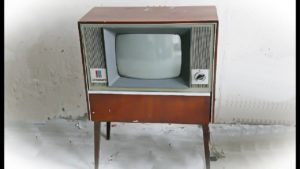 We are used to having modern flat-screen TVs installed in our apartments, which show many channels and transmit a clear and bright picture. In Soviet times, everything was absolutely different. In those days, not every apartment had a TV, and not only relatives, but neighbors came to watch the program. They brought stools with them and sat down to watch the long-awaited program. This is exactly how the path of this technology in our country began. Let's look at which models Soviet people liked most, and when Soviet residents got the opportunity to watch color programs. The development of technology has not stood still and we can see this in our own home. After all, modern televisions are radically different from those Soviet models, which worked without sound and showed low-quality pictures. So when did television appear in our grandmothers' homes?
We are used to having modern flat-screen TVs installed in our apartments, which show many channels and transmit a clear and bright picture. In Soviet times, everything was absolutely different. In those days, not every apartment had a TV, and not only relatives, but neighbors came to watch the program. They brought stools with them and sat down to watch the long-awaited program. This is exactly how the path of this technology in our country began. Let's look at which models Soviet people liked most, and when Soviet residents got the opportunity to watch color programs. The development of technology has not stood still and we can see this in our own home. After all, modern televisions are radically different from those Soviet models, which worked without sound and showed low-quality pictures. So when did television appear in our grandmothers' homes?
The content of the article
The first televisions in the USSR
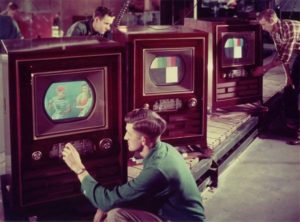 As you know, the first equipment of this type appeared in the USSR. Then these were black and white models of equipment, but they were also a real miracle for Soviet people. Not everyone knows when televisions appeared in the USSR, but everyone knows that it was a real sensation. The equipment was often located in one house in the village or in one or two city apartments, and all relatives and neighbors gathered to watch television. Television began its activity in our country in 1931. It was this year that the first television broadcast took place. People watched black and white programs and were happy with it, but the development of technology moved forward uncontrollably and the appearance of the first color TV was just around the corner.
As you know, the first equipment of this type appeared in the USSR. Then these were black and white models of equipment, but they were also a real miracle for Soviet people. Not everyone knows when televisions appeared in the USSR, but everyone knows that it was a real sensation. The equipment was often located in one house in the village or in one or two city apartments, and all relatives and neighbors gathered to watch television. Television began its activity in our country in 1931. It was this year that the first television broadcast took place. People watched black and white programs and were happy with it, but the development of technology moved forward uncontrollably and the appearance of the first color TV was just around the corner.
It's hard to believe that not so long ago people did not have the opportunity to watch TV, change channels and choose interesting films or programs among an endless number of channels that show a clear and bright picture.
The first color TV in the USSR
It is quite clear that the first technology of this type was very primitive by modern standards.
REFERENCE. Soviet designers sought to be in no way inferior to the United States, proof of this was the literally parallel development of technology.
Stages of production of color equipment:
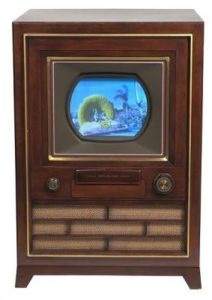 In the 50s of the last century, a telescope was developed that used electron guns. They were at a certain angle relative to each other. This device was equipped with an electronic sweep variation. Three beams came out of the cannon, which accumulated in the mask, after which they hit the screen.
In the 50s of the last century, a telescope was developed that used electron guns. They were at a certain angle relative to each other. This device was equipped with an electronic sweep variation. Three beams came out of the cannon, which accumulated in the mask, after which they hit the screen.- In 1954, Westinghouse in America offered the H840SK15 for sale. This option quickly burned out due to its high cost.
- In 1965, the Temp and Rainbow models, known to every Soviet citizen, were invented.
Subsequently, the development of technology continued at a very dynamic pace, new models appeared, and people got the opportunity to view color and high-quality images.
Which models were preferred by Soviet buyers?
Soviet buyers had their own preferences when choosing a TV, let's consider them:
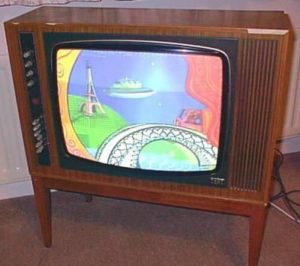 In 1931, the B32 model was released.Production continued in large volumes from '33 to '36. The screen dimensions were 16x12 mm. Initially, the equipment was produced in the form of a set-top box, which was attached to a radio operating in the medium wave range.
In 1931, the B32 model was released.Production continued in large volumes from '33 to '36. The screen dimensions were 16x12 mm. Initially, the equipment was produced in the form of a set-top box, which was attached to a radio operating in the medium wave range.- At the end of the 30th decade, American technologies were introduced. They even tried to create several models under US license. But this was not successful as the war began.
- KVN-49 was loved by users. The technology was developed at the Leningrad Research Institute. A special feature is a non-standard hinged lens, which was designed to enlarge the picture.
- In 1957, the production of the well-known Ruby was established. The Rubin 102 TV could show up to 12 channels, and the manufacturers also provided the ability to connect a tape recorder.
- Rassvet 307 was even more popular. Speaking in numbers, 8 million models were sold.
- Another well-known and popular model is Rubin 312. The Horizon TV, produced in the 80s, was a model in short supply.
How was TV invented?
Despite the fact that the first television became available for mass use only in the 30s of the 20th century, attempts to create a television receiver began much earlier. Back in the 19th century, mechanic Paul Nipkivov worked on such an idea.
After going through a long journey of trial and error, the designers still managed to create a miracle of technology. At first these were just clear pictures that could be broadcast without sound, and then the design was improved.
The first television in the USSR was a mechanism with a very simple structure and a very compact screen. The screen dimensions were only 3x4 cm.
REFERENCE. The production of televisions in the USSR started in 1938, which is a year earlier than in the USA.
What was the name of the first mass-produced television in the USSR?
If you do not take into account many test developments, then the first serial color TV in the USSR was Rubin 401. The first broadcast that could be watched in color format was released on November 7, 1967. This became possible thanks to agreements between France and the Soviet Union. We are talking about the introduction of French Segam technology. People most loved the brand of color TV Rubin 714 with a large diagonal screen.
REFERENCE. By the end of the 80s, more than 50 million televisions were sold.
The television of those times was arranged as follows:
- On the left side of the case there was a main block with settings, a radio channel and a transformer. On the right side there were scanners with lamps.
- The estimated range of the device is meter. For decimeter channels it was supposed to use a special attachment. After this, SKD blocks were produced.
IMPORTANT. A new stage in the production of this technology was the transition to transistors, which could be assembled from microcircuits.
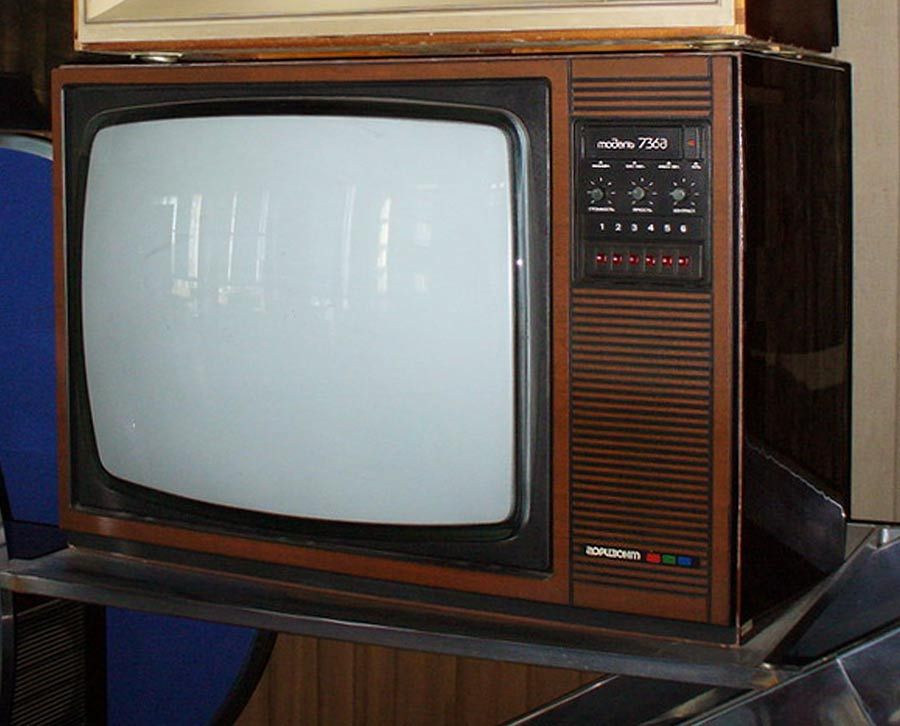
Oh, just don’t boast about the Horizon brand! They know how to make lard!
author, do you read at least a little technical literature, not a telescope but a kinescope, and the mask did not accumulate the rays but divided them, a color separation mask
There is a mistake in every sentence. Not spelling, but technical.
I tried to assemble a transistor from microcircuits, as the author writes... I couldn’t stand it, got drunk and gave up the idea...
And not Segam, but secam!!!
In the 70s, at the VDNKh exhibition in Moscow, they boasted about color televisions and promised that in the 2000s there would be holography rather than televisions! I remember this well and they even said that the USSR would explore Mars! But where is it all? Even in developed countries this is not the case! Although the United States is successfully exploring Mars with its all-terrain vehicles!
Zhiguli never cost 4 thousand
Russia is not even close and has never stood next to the United States.






In the USSR, until 1972, all radio factories worked on independently developed models of TV receivers. Even Combine Harvesters such as Belarus were produced. Which had a radio, TV and record player.
A characteristic feature of this system is the combined channel of the IF radio and TV receiver on the VHF range.
After 1972, when a new GOST for radio equipment was adopted, all factories began production according to a single scheme set by the radio industry.The difference was that the receiver assembly from the Riga Tauras could not be “stuck” into the Moscow Chaika or Rubin. although the electrical circuits were identical. The node pairings were different. That's all modernization is. The first tube TV cost exactly 1000 rubles, which is a third of the Zaparozhets and a fourth of the Zhiguli...